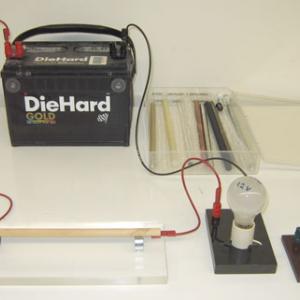College of Liberal Arts & Sciences
5A30.15 - Conductors & Insulators
While the conductors or non-conductors may be snapped into the holder, it is not necessary for the demonstration to work. Just lay the rod on top of the contacts to see if they are either conducting or non-conducting. It is especially recommended that you do not try to snap the carbon rod into the holders as this will probably break the rod.
The small electronic circuits are designed to show conduction of the human body. The one with the LED will light up when the two leads are held, and the intensity of the LED will vary with the resistance of the body. The one with the speaker will have a different pitch according to the resistance of the body when the leads are held.
- James Lincoln, "The Energy Stick", TPT, Vol. 57, #9, Dec. 2019, p. 652.
- Richard J. Fitzgerald, "An Insulator with Conducting Electrons?", Physics Today, Vol. 68, #9, Sep. 2015, p. 18.
- Grant Mellor, "What is a Voltaic Electricity?", Flying Tinsel, 1993, p. 77 - 79.
- Grant Mellor, "Conductors and Insulators", Flying Tinsel, 1993, p. 51 - 55.
- Herb Strongin, “Conductors and Insulators“, Science on a Shoestring, p. 158.
- Borislaw Bilash II, “Group 14: Metals versus Nonmetals“, A Demo A Day – A Year of Physical Science Demonstrations, p. 136.
- Borislaw Bilash II, “Conductors versus Insulators“, A Demo A Day – A Year of Physical Science Demonstrations, p. 268.
Disclaimer: These demonstrations are provided only for illustrative use by persons affiliated with The University of Iowa and only under the direction of a trained instructor or physicist. The University of Iowa is not responsible for demonstrations performed by those using their own equipment or who choose to use this reference material for their own purpose. The demonstrations included here are within the public domain and can be found in materials contained in libraries, bookstores, and through electronic sources. Performing all or any portion of any of these demonstrations, with or without revisions not depicted here entails inherent risks. These risks include, without limitation, bodily injury (and possibly death), including risks to health that may be temporary or permanent and that may exacerbate a pre-existing medical condition; and property loss or damage. Anyone performing any part of these demonstrations, even with revisions, knowingly and voluntarily assumes all risks associated with them.


